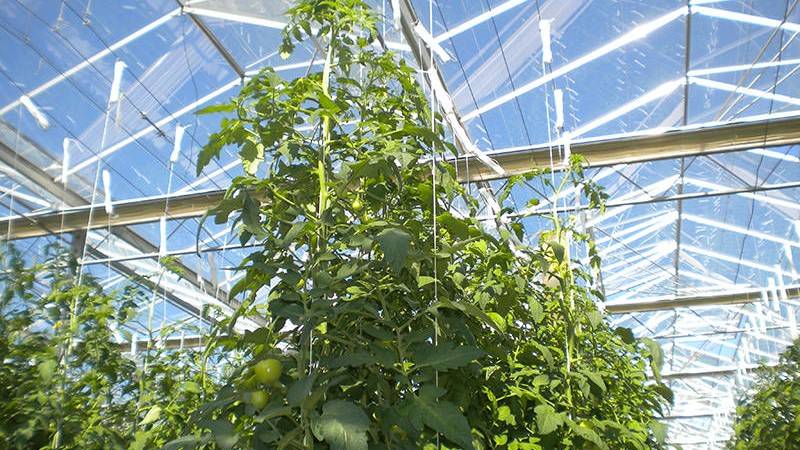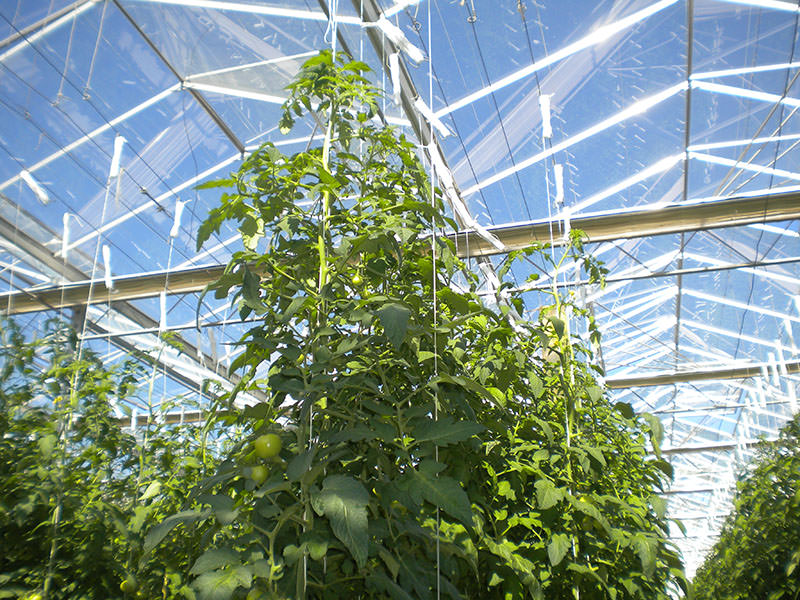Greenhouse Herb and Vegetable Production – Part 2/4 – Greenhouse Structure


In this second part of our four-part series on growing vegetables and herbs in the greenhouse, we will focus on the greenhouse structures needed to produce quality crops. Again, the focus will be on starting a greenhouse production facility from the ground up, but this makes a good checklist to see if your existing facility would be favorable for vegetable and herb production.
Levels of Technology
High Tech
The frame of the greenhouse can be made of steel or aluminum covered with glass, polyethylene or polycarbonate. Plants are grown in a soilless substrate and there is full control over the computerized, automated drip irrigation system (which monitors EC, pH, irrigation duration and frequency). Cooling is active and includes heating systems. Yields will be the highest with tomatoes averaging 90 kg•m2 per year with an investment over US$110•m2.
Medium Tech
The frame of the greenhouse can be made of steel covered with double polyethylene or rigid plastic. Plants are grown in a soilless substrate or the soil floor, and drip irrigation is managed with computers (irrigation duration and frequency). Cooling can be passive or active, and with or without heating. Yields will be moderate with tomatoes averaging up to 45 kg•m2 per year with an investment below US$110•m2.
Low Tech
The frame of the greenhouse can be made of steel or wood covered with a single polyethylene film. Plants are grown in the soil floor and drip irrigated with manual control. Cooling is passive and there is no heat source. Yields will often be low with tomatoes averaging about 20 kg•m2 per year with an investment of no more than US$35•m2.
Load Considerations
Depending on your climate and location, these factors need to be considered when building a greenhouse. Keep in mind that plants that climb support wires that are attached to the frame also add extra load to the structure.
Dead Load
Weight of the permanent construction such as structure, covering (glass is heavier than polyethylene) and equipment attached to the structural members. Plants or equipment attached to the structure for more than a month have to be considered as dead load.
Live Load
Weight superimposed by use: vegetable plants attached to a high wire, hanging baskets, shelves, and any equipment attached to the structure for less than one month.
Wind Load
Loads caused by winds from any direction. The design has to be made to sustain the maximum wind speed over the last 100 years.
Snow Load
The weight of a snow load has to be considered per square foot, the heating system to melt the snow and the roof design.
Coverings
Glass
A single layer of glass can transmit 94% of the light (or photosynthetic active radiation), it is transparent, is resistant to UV light, heat, and temperature extremes, low flammability, does not turn yellow over time, heavyweight, expensive, low impact resistance (hail) and it can last for more than 25 years.
Acrylic
A single layer of glass can transmit 93% of the light (or photosynthetic active radiation), it is resistant to UV light and weather, lightweight, does not turn yellow over time, slightly weakens over time, is costly, easily scratched, flammable and it can last for more than 20 years.
Polycarbonate
A single layer of polycarbonate can transmit 93% of the light (or photosynthetic active radiation), is lightweight, has low flammability, can resist hail, is easy to bend, is affected by high or low temperatures, is costly, easy to scratch, and it can last for more than 15 years.
Fiberglass
A single layer of fiberglass can transmit 90% of the light (or photosynthetic active radiation), is lightweight, inexpensive, durable, turns yellow with age, is susceptible to UV light, pollution and dust, highly affected by high or low temperatures, and it can last for more than 15 years.
Polyethylene Film
A single layer of polyethylene can transmit 85% of the light (or photosynthetic active radiation), is inexpensive, easy to install, not durable and has a short life of up to 3 years.
Important Considerations for All Coverings
Keep them clean; dust reduces incoming light. Consider using plastic films with anti-condensation coating. Droplets on the plastic film coverings diminish light transmission and they can accumulate and fall on the leaves of the plants, which may cause diseases. The use of coverings with double layers decreases heat loss; however, they reduce light transmission.
Type of Greenhouse
Single-span: is a single greenhouse structure. The most popular are hoop (ground to ground), arch roof, gable roof, cold frame and Gothic.
Multi-span: multiple gutter-connected greenhouses. The most popular are arch roof, gable roof, sawtooth, Venlo, Gothic and high tunnel.
Height of Greenhouse
Depends on the type of crop grown. For example, the recommended height of the support cable for tomatoes is from 8 – 22 ft; therefore, the minimum height should be 22 ft. It is recommended to build tall greenhouses since they provide more air “buffer” capacity (air volume) against rapid changes from the outside environment. In addition, the extra volume of air helps to improve cooling because the warm air will rise above the plant canopy. Moreover, tall greenhouses leave more space for the installation of supplemental light, overhead irrigation, shade and thermal cloth, benches and hanging baskets.

Orientation
A multi-span greenhouse for tall plants like tomatoes should be north-south oriented (the rows of plants have to be parallel to the gutter and also run from north to south). The sunlight received by the crop is more uniform across the width of the greenhouse from sunrise to sunset, especially in latitudes over 30˚ north or south.
If the same greenhouse and the rows of plants were oriented east-west, the plants located on the north end of the greenhouse would receive less light due to shadows from the south plants. In addition, the first couple of rows on the south end of the house would receive less light than the middle rows of the greenhouse due to shading from the south wall. Both facts are more noticeable during winter because the sun is lower in the sky and stays closer to the horizon. For short plants like lettuce, east-west orientation will have little impact from shadows even during winter. Plants in a Quonset or ground-to-ground greenhouse will receive more light than in a gutter-connected greenhouse because they have less structure.
In the third part of this series, we will talk about the greenhouse environment and what is ideal for growing greenhouse vegetables and herbs.